Recent Articles
Popular Makes
Body Types
2018 Mazda CX-3 vs Honda HR-V: Which is Best?
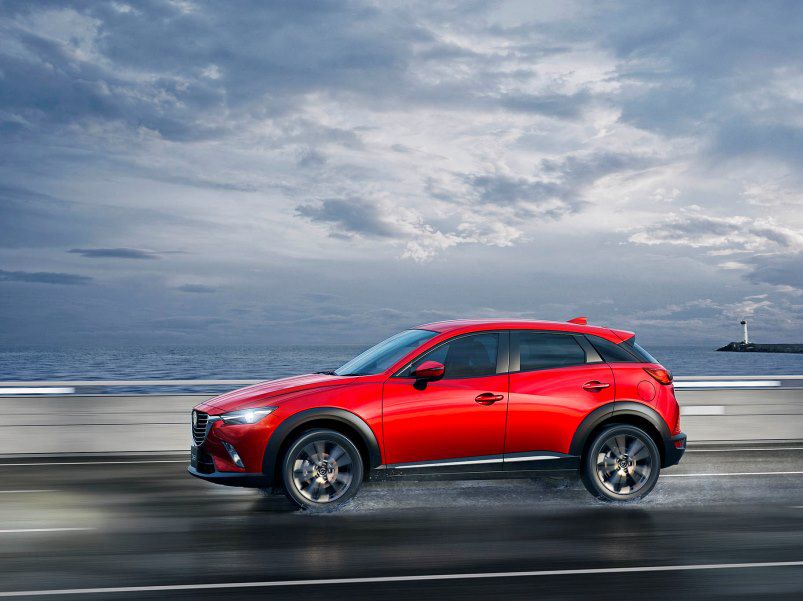
2016 Mazda CX 3 012 ・ Photo by Mazda
The 2018 Mazda CX-3 and 2018 Honda HR-V are subcompact crossovers that are relatively new to the scene. Both debuted over the last few years as crossovers became the hottest thing since minivans. A subcompact crossover’s appeal lies in its flexibility to offer the benefits of SUVs with more affordable pricing.
They’re a great choice for those who need extra room for cargo, but not quite as much as what you’ll find in larger SUVs. A subcompact crossover’s smaller footprint also makes it ideal for those in urban areas where streets are congested and parking is tight. Let’s take a closer look at the Mazda CX-3 and Honda HR-V and see which of them is the best.
Pricing
The base Honda HR-V LX with front-wheel drive comes in with a starting price of $19,670. This model features a six-speed manual transmission, but it can also be had with a continuously variable automatic transmission for an extra $800. This bumps the starting price up to $20,470.
The base Mazda CX-3 Sport also features front-wheel drive and has a low starting price of $20,110 making it slightly pricier than the base HR-V, but there’s one big difference: It comes standard with a six-speed automatic transmission. Compared to the similarly equipped HR-V it’s a better deal.
: Mazda CX-3

Photo by Mazda
Safety
crossovers often have kids in tow, making safety a priority. The Insurance Institute for Highway Safety awarded the HR-V its highest rating of Good in all crash tests except for small front overlap on the driver side, which received an Acceptable rating. It was not rated at all for crash avoidance and mitigation technology because those features aren’t available on the HR-V, even as an option.
The Mazda CX-3 fares much better. It received Good scores in every crash test and a top Superior rating based on the performance of its front-crash prevention technology. This was enough to make it a 2018 IIHS Top Safety Pick. This one isn’t even close.
: Mazda CX-3
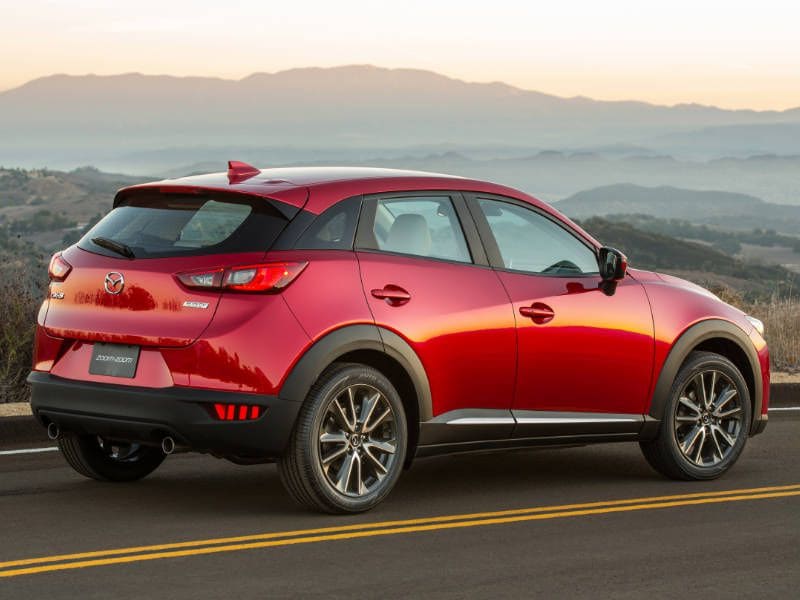
Photo by Mazda
Seating
The Honda HR-V offers seating for five passengers with manually adjustable cloth front seats in the base model. Those seats are heated starting in the EX trim and leather-trimmed in the top EX-L Navi trim. Rear passengers get 38.3 inches of headroom and 39.3 inches of legroom.
There’s also seating for five passengers in the Mazda CX-3 with a six-way manually-adjustable driver’s seat standard. The Touring trim adds three-level heated front seats and swaps the cloth for leatherette trims, while the top Grand Touring adds leather trim and suede inserts. There are 37.2 inches of headroom in back and 35.0 inches of legroom, which falls short of what’s offered in the HR-V.
: Honda HR-V
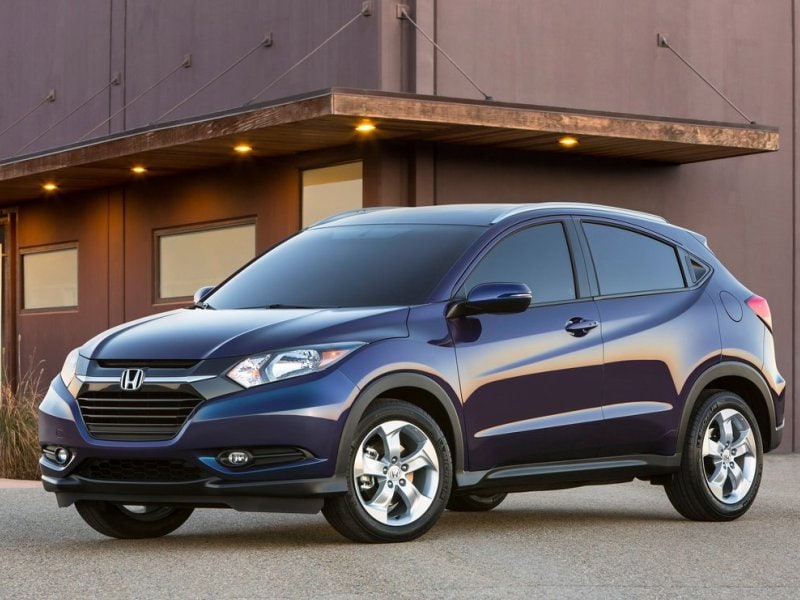
Photo by Honda
Fuel Economy
Along with their more affordable pricing, subcompact crossovers also often offer better fuel economy than their larger counterparts. The Honda HR-V gets an EPA-estimated 25 mpg in the city, 33 mpg on the highway and 28 mpg combined in front-wheel drive models with a manual transmission. Numbers jump to 28 mpg city/34 mpg highway/31 mpg combined with the continuously variable automatic transmission. Sitting in the middle are the all-wheel-drive models, offered only with the automatic, with an EPA-estimated 27 mpg city/31 mpg highway/29 mpg combined.
The CX-3 gets an EPA-estimated 29 mpg city/34 mpg highway in front-wheel drive models and 27 mpg city/32 mpg highway in all-wheel-drive models. The CX-3 manages to eke out slightly better mileage than the HR-V in both front-wheel and all-wheel-drive models and takes the win.
: Mazda CX-3
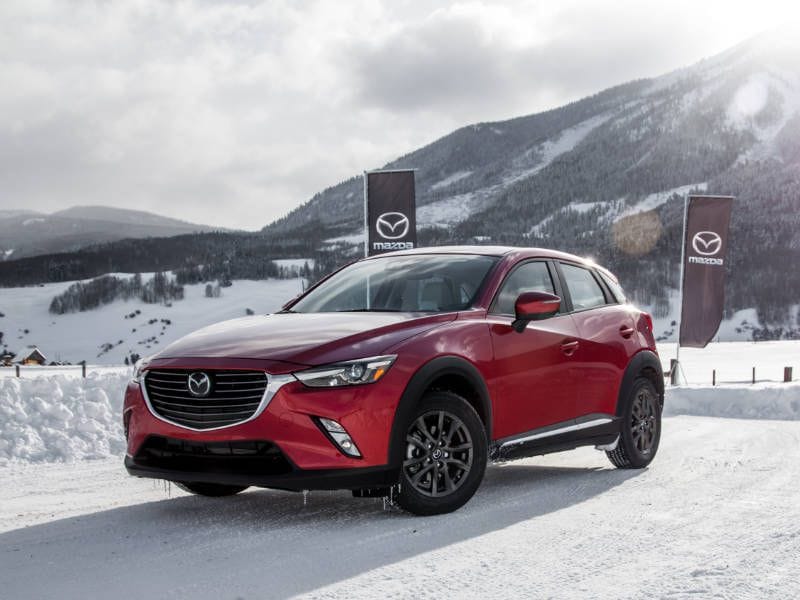
Photo by Mazda
Cargo
Both the Honda HR-V and Mazda CX-3 offer a 60/40 split-folding rear seat for flexibility when loading cargo. In the HR-V, there are 24.3 cubic feet of cargo with the rear seat up and 58.8 cubic feet with the seat down. The numbers take a slight drop in all-wheel-drive models, to 23.2 and 57.6 cubic feet, respectively.
The base CX-3 Sport comes in with 12.4 cubic feet of cargo space with the rear seat up and 44.5 cubic feet with the rear seats folded. In Grand Touring models the numbers drop to 10.1 cubic feet and 42.3 cubic feet. If cargo is your priority, then the HR-V is the clear winner.
: Honda HR-V
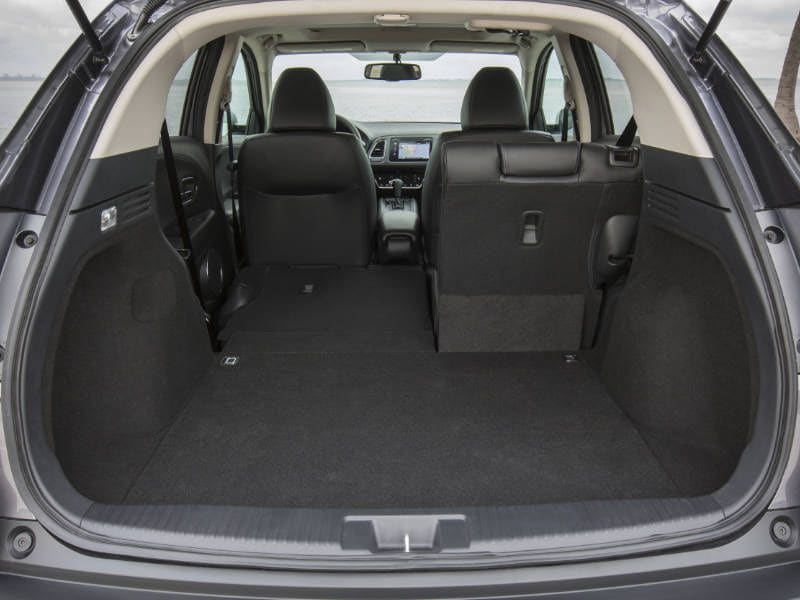
Photo by Honda
Infotainment
Standard infotainment in the Mazda CX-3 features a 7-inch color touchscreen with a six-speaker audio system, AM/FM/CD, and MP3. There’s also Mazda Connect, which includes Aha, Pandora, and Stitcher. The Touring trim adds the option for a seven-speaker Bose audio system, HD radio, and Sirius XM, which all become standard on the Grand Touring along with navigation.
The base infotainment system in the HR-V includes a 5-inch color screen and four-speaker audio system, AM/FM/CD and MP3. The EX adds a 7-inch color touchscreen with a six-speaker audio system, Pandora, and HondaLink phone connectivity. The EX-L Navi adds navigation, SiriusXM, and HD Radio. There’s no option for a premium audio system on any trim level.
: Mazda CX-3
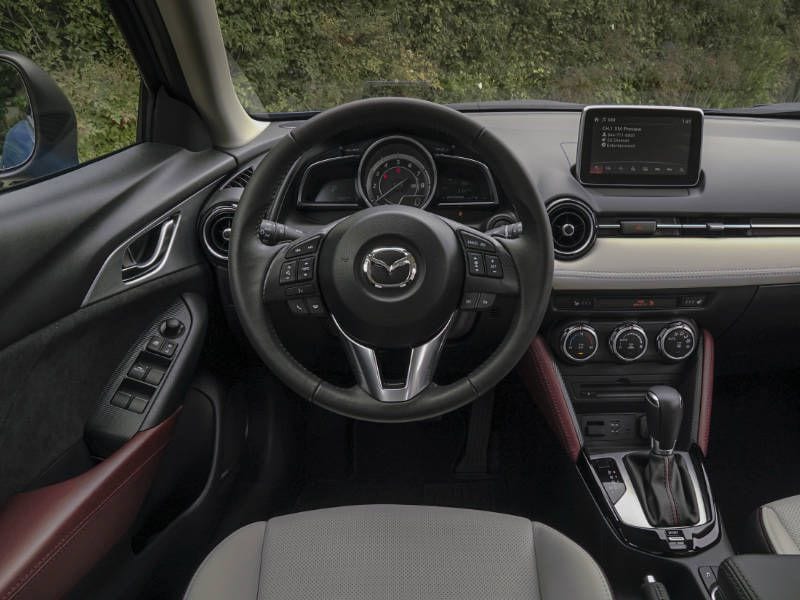
Photo by Mazda
Performance
Power for the Mazda CX-3 comes from a 2.0-liter four-cylinder engine with 146 horsepower and 146 lb-ft of torque paired to a six-speed automatic transmission. It’s your only powertrain choice across the lineup.
The Honda HR-V is powered by a 1.8-liter four-cylinder engine with 141 horsepower and 127 lb-ft of torque with a choice of transmissions: a six-speed manual or a continuously variable automatic. Although the HR-V offers more choice with its transmissions, its smaller engine makes acceleration lackluster and merging into high-speed traffic more challenging. The CX-3 is also quieter thanks to its use of a conventional automatic transmission.
: Mazda CX-3
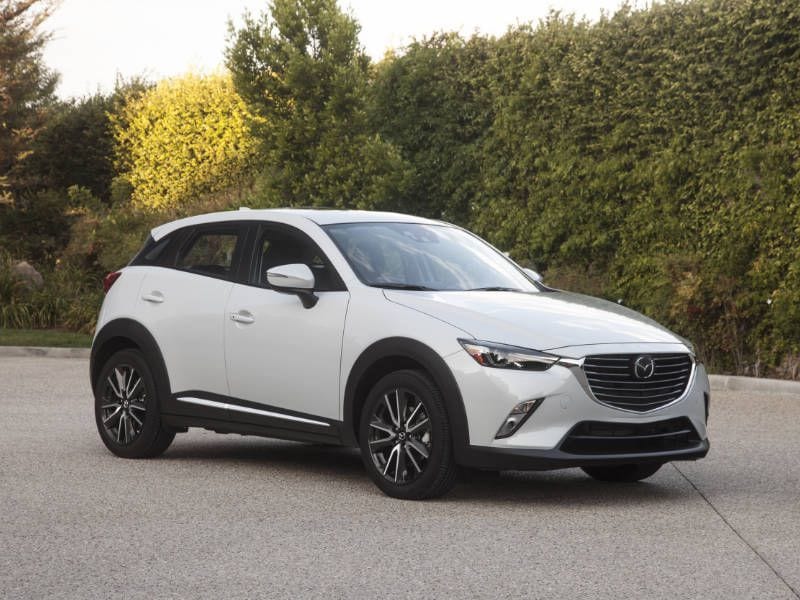
Photo by Mazda
Ride and Handling
These are both economy crossovers, so they don’t feature particularly powerful engines or sharp handling. There are larger crossovers like the Honda CR-V and Mazda CX-5 that provide more power and a more engaging driving experience. Mazda, however, has something of a reputation for building cars people like to drive and it shows in the CX-3.
Steering is tight and precise and, although not sporty, the CX-3 is easy to toss through the curves at highway speeds. The ride is smooth even on rough surfaces and the cabin is quiet with no unwanted engine noise. The HR-V is less nimble with a stiffer ride and engine noise that is intrusive, especially during hard acceleration.
: Mazda CX-3
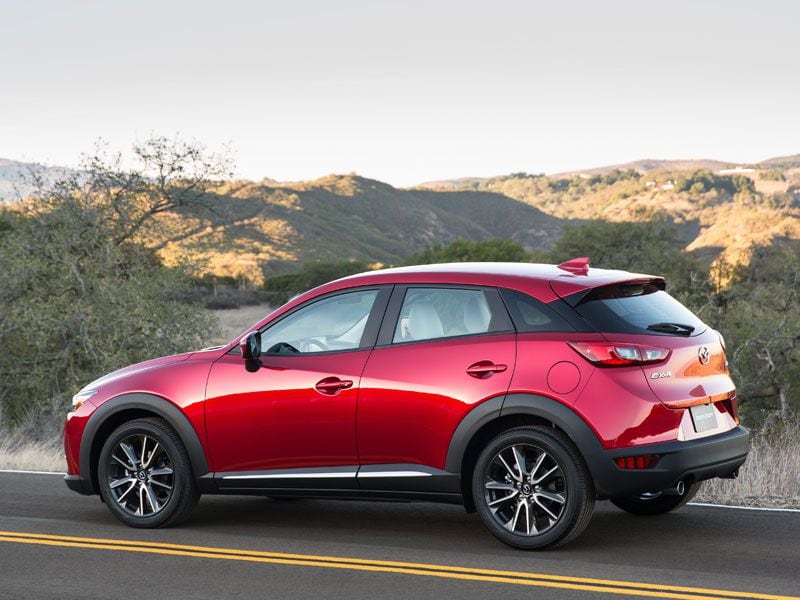
Photo by Mazda
Styling
The Honda HR-V features styling in line with the Honda SUV lineup, which means it’s not a standout. It’s attractive and modern, but not something that will attract attention. Inside, materials are of a good quality and comfortable without being anything special. The HR-V does its job without any fuss.
Likewise, the CX-3 takes its cues from the rest of the Mazda lineup — making it a more stylish vehicle. Lines are more curved and sporty, so it stands out from other crossovers. Inside, the story is the same with a modern, elegant interior that feels like more than it costs.
: Mazda CX-3
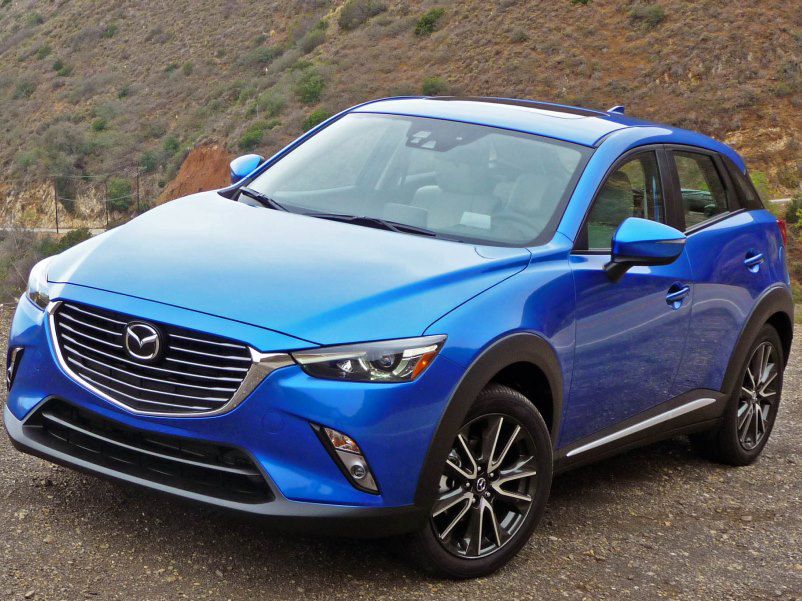
Photo by Mazda
Verdict
This contest wasn’t even close. If you’re focused solely on cargo capacity, then the Honda HR-V is the winner. It also offers slightly more rear passenger space, which is a plus. In every other category, the Mazda CX-3 comes out as the clear winner.
It offers a better combination of fuel efficiency, features and power in a more stylish package than the HR-V. It also presents a better value with a wider range of standard features on the base model and available options you can’t even find on the HR-V no matter the trim you choose.
: Mazda CX-3

Photo by Mazda